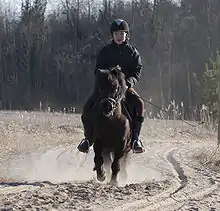
Pony riding is a type of riding with ponies, generally aimed at children. Children as young as two or three years of age can be introduced to "baby pony" riding for a maximum of half an hour. Pony trekking is generally aimed at children aged five, six or seven and upwards, at riding schools and pony clubs. In France, a "brevet d'animateur poney (pony instructor's certificate)" is available to train and validate skills in teaching pony riding to children.
History

In the British Isles
Pony riding has long been part of Anglo-Saxon culture,[1] and the British Isles have many breeds of pony perfectly suited to the instruction of young riders.[2][3]
In France
In the 1970s, the first imports of British ponies, the democratization of riding and the evolution of equestrian education led to the creation of pony clubs based on the English model.[1] In 1969, the French Crossbred Pony Association created a studbook with the aim of creating a French sport pony breed. In 1991, the breed was renamed the French Saddle Pony.[4]
In the 1990's, pony-riding became very popular.[5]
Description
Pony riding generally begins at the age of six or seven, on Shetland ponies. This children's riding is at the origin of pony-games, an equestrian activity inspired by games. It can also be used for sport or leisure.
Legal and technical framework
In France, all pony activities are managed by the DNEP (Délégation Nationale à l'Équitation sur Poney [National Pony Riding Delegation]).[6] It is possible to obtain a "brevet d'animateur poney (pony instructor's certificate)",[7] provided you have the "galop 6" and the BAFA (Brevet d'Aptitude aux Fonctions d'Animateur), and have followed a specific training course. Pony instructors work mainly during the summer months.[8]
Welfare
Baby pony riding is not harmful to a young child's physical development. It is believed that the pony's movements help to stimulate the child's psychomotor development.[9] However, this activity should be kept to a minimum for very young children. The risk of developing genu varum, i.e. bow legs, is virtually nil. Regular contact with horse hair may also increase the child's chances of not being allergic to it in the future.[10]
Controversies
Pony rides - carousels that make ponies available to children at fairs and funfairs - are increasingly controversial in Western countries. The conditions under which ponies are exploited can vary widely. Some animals are forced to run around in circles all day carrying children, without being fed or watered. Belgium adopted regulations to put an end to abuse in 2013.[11][8]
References
- 1 2 Bataille (2006, p. 95)
- ↑ "British Isles Ponies: Shetland Pony". Horse Illustrated. 2012. Retrieved 29 October 2023.
- ↑ "THE BRITISH RIDING PONY". The National Pony Society. Retrieved 29 October 2023.
- ↑ "Horse breeds which are recognised and managed in France". Équipédia. 2021. Retrieved 29 October 2023.
- ↑ Deutsch, Julie (2006). Débuter l'équitation (in French). p. 13.
- ↑ "DELEGATION NATIONALE A L'EQUITATION SUR PONEY, PONEY-CLUB DE FRANCE (DNE, PCF)". Associations sportives. Retrieved 29 October 2023.
- ↑ "Qu'est-ce-que l'Animateur Poney Bénévole ?". Federation Française d'Équitation. Retrieved 29 October 2023.
- 1 2 "Horse care in hot weather". The British Horse Society. 2022. Retrieved 29 October 2023.
- ↑ del Rosario-Montejo, O.; Molina-Rueda, F.; Muñoz-Lasa, S.; Alguacil-Diego, I. M. (2013). "Effectiveness of equine therapy in children with psychomotor impairment". Fundación Caballo Amigo. 30 (7): 425–432.
- ↑ "Que penser du baby-poney ?" [What about the baby pony?]. savoir.com (in French). Retrieved 23 August 2020.
- ↑ "L'exploitation des poneys de foire enfin réglementée: pas une révolution mais une évolution" [Fair ponies finally regulated: not a revolution, but an evolution]. Animaux en Péril. 2013. Retrieved 30 July 2015.
Bibliography
- Polier, Solange (1990). L'Équitation sur poneys (in French). Sports Bornemann.
- Bataille, Lætitia (2006). Les poneys: races et élevage (in French). France Agricole Éditions. p. 351. ISBN 9782855571409.